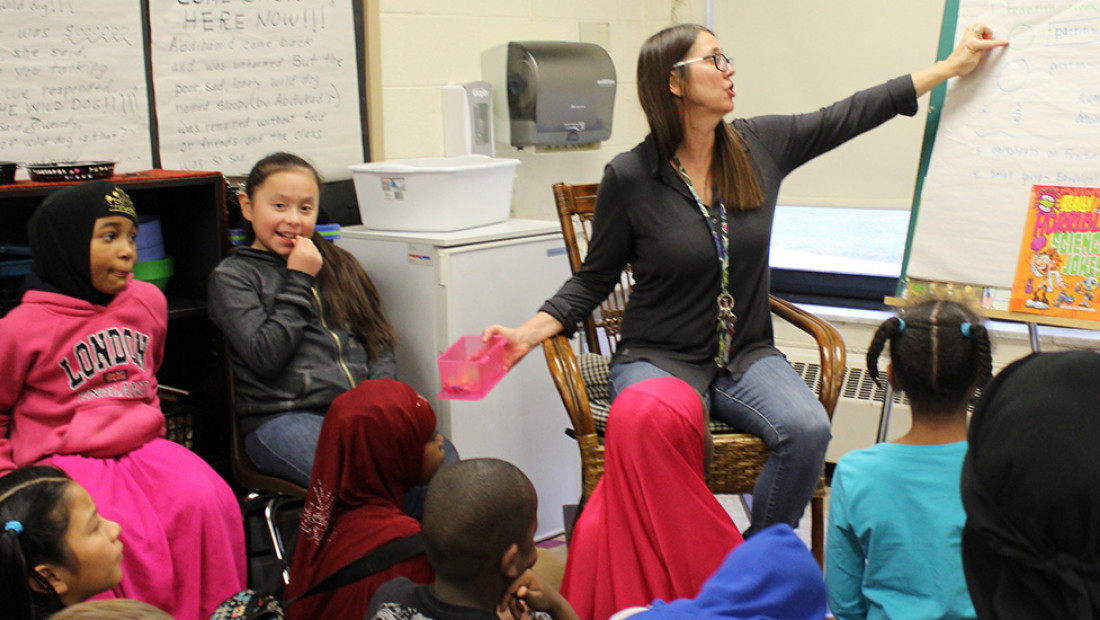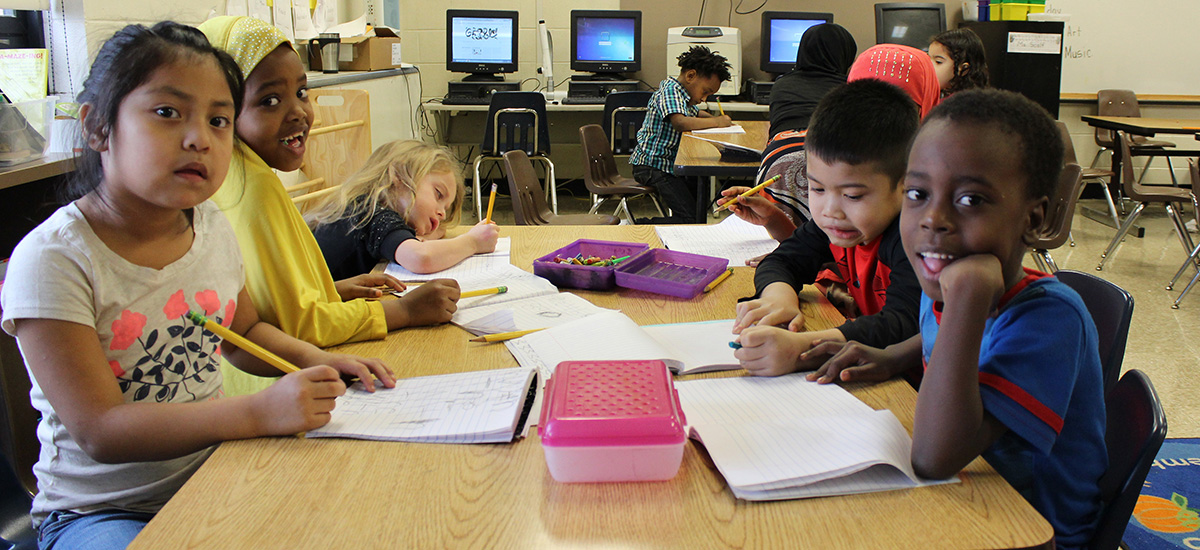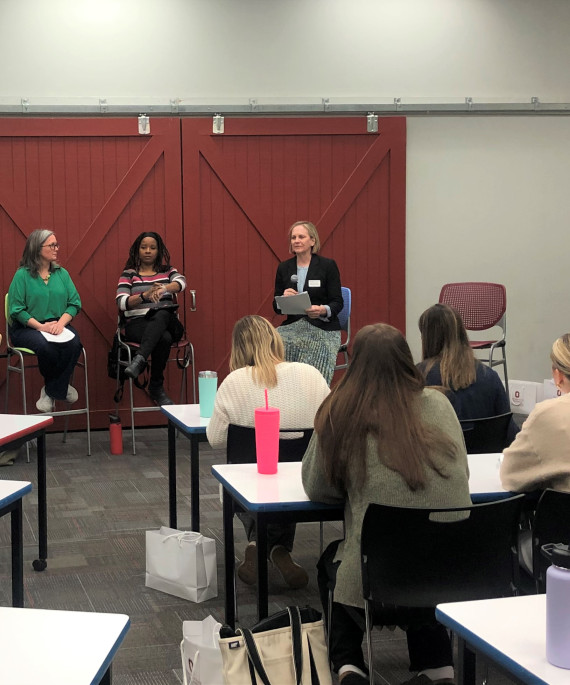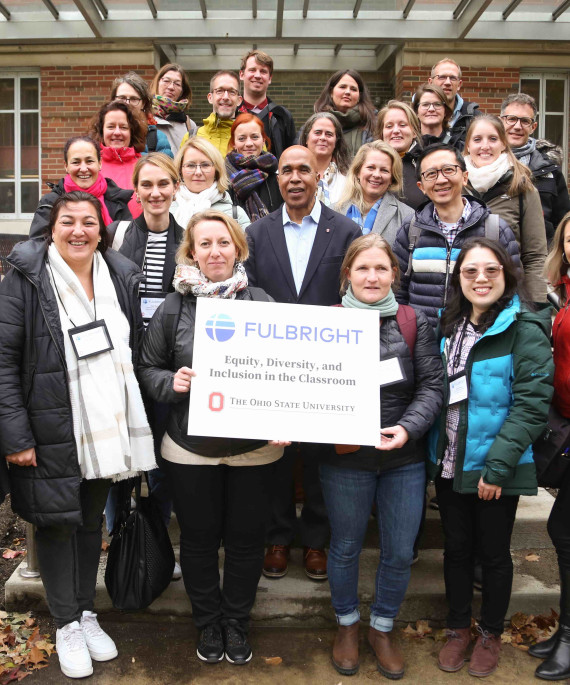
Third-grade teacher Kelly Montgomery conducts a lesson at Eakin Elementary School in Columbus.
Grant aims to help teachers, parents, children overcome English language barriers
The small girl wearing pink tennis shoes and a matching hijab searches for words to answer why she was in the principal’s office.
“I need to see the nurse,” comes her whisper-soft request.
“What hurts?” a kindly staff member asks.
The girl struggles to answer, until the woman pantomimes, touching her head, then stomach. The girl catches on, and clutches her throat.
The hard part comes after the nurse examines the girl. The staff at Eakin Elementary School must call her parents and tell them she’s sick. And chances are the parents know even less English than the child.
When it comes to impediments to learning, one group of students in particular must scale multiple hurdles in U.S. schools.
English language learners must adjust to a new culture and master new academic skills, all while picking up a new language. To boot, they have a distinct disadvantage compared to other classmates: Their parents struggle to help them learn. And, when mom and dad don’t speak English at home, children are at significant risk to perform more poorly in school.
New research by the College of Education and Human Ecology aims to level the playing field by better equipping teachers of English language learners and giving parents new technology tools to overcome language barriers. Helping their children with school may soon be as easy as tapping a play-button on a smartphone.
If you don’t speak the language
Immigrant and less-educated parents want to be active in their children’s learning. A 2015 Pew Research study found that 67 percent of Latino parents, for example, think a parent can never be too involved in a child’s education. (The number for white parents was much smaller.)
But these parents can feel helpless when trying to gain information about their children’s grades and homework. Then, language and cultural differences can be obstacles to their involvement.
Nowhere is this be more apparent than at a school like Eakin, on Columbus’ West Side. Nearly 70 percent of students there are English-language learners — the largest number in Columbus City Schools. Of those, nearly 80 percent are Somali and about 20 percent are Latino, said Principal Theresa Eraybar, ’85 BS, ’90 MA.
Some families have nine or 10 children who span many grades. Nearly all live nearby in a sprawling apartment complex called Wedgewood Village.
“You’ve got your first-generation folks right out of refugee camp (many in Kenya),” she said. “Then you have the second and third generation families.”
If the parents haven’t been schooled in the United States, they rarely speak, read or write in English.
“The needs of just the children aren’t the only piece,” she said. “It’s also the needs of my families – having to navigate school and navigate how to support their child.”
Older children sometimes translate younger siblings’ school materials to a parent — but their interpretation can miss the mark or even mislead parents. A child might tell parents that a “1” on a report card is a good mark, instead of the lowest grade, Eraybar said.
What parents most need is a means to decipher the teacher’s message in their own language.
Belinda Gimbert, associate professor of educational administration, received a $2.7 million training grant from the U.S. Department of Education to do just that. Rebecca Parker, in the college’s Center on Education and Training for Employment, provides crucial project management support to manage the grant.
By training all teachers in the school, the grant will help develop practices to spur language proficiency in the classroom: using student-to-student, peer-assisted learning; providing in-person and online professional development; and bolstering support for children who have suffered trauma, or who have learning difficulties or behavioral needs.

Then there’s the web app
“The second scope of work really looks at how we can use technology — specifically smart phone technology and perhaps some virtual learning technology — to augment the work being done in the classroom with parent support at home, especially around homework,” Gimbert said.
Daily, 30-second videos will demonstrate in Mai Mai, the Somali Bantu language, key instructions for parents helping their kindergartners to learn, for example, letter sounds.
“So, they can actually understand what they need to do to support their kindergartner who’s trying to identify five items that start with the letter ‘A’ and understand that the sound is ‘aaa,’” Gimbert said.
The videos will be sent to parents via text messages containing a web link. (Almost all parents have smart phones, which they rely on heavily to communicate with family back home.) The videos could feature a Somali mother reading to her child, instructing parents to point at words, use picture clues and other early literacy learning techniques.
“It’s showing models of lessons – not lessons of what the teacher teaches but what you do as a parent to help your child,” Eraybar said.
The project will be conducted concurrently in Houston with Latino families and in Washington, D.C., with Ethiopian families.
“We wanted to reach beyond Ohio knowing that partnership is such a critical piece of the work that we’re doing in education now, and knowing that we could build on the work that we had successfully completed in our previous grant,” called Mobilizing National Educator Talent, Gimbert said.
That grant created online teaching modules to certify nontraditional teachers.
Using those existing mobile friendly materials means Gimbert and Parker don’t need to start from scratch with this grant.
“We’re able to extend that and modify the digital resources,” she said.
The grant will allow Eakin teachers and staff to refine and “kick up a notch” what they are already doing to serve the English language learners, Eraybar said.
Training all teachers will change the mindset that struggling students always need to go to the English-as-a-second-language teacher. “We’re going to utilize strategies and methodology that meets the needs of all the children. Whether you’re an ESL teacher or a regular education teacher or a special ed teacher, you’re going to use the strategies. And that’s where this grant provides an avenue to strengthen what we are trying to do.”
And helping parents help their children is an integral part of the plan.
“They desperately want their children to do well,” Eraybar said.




